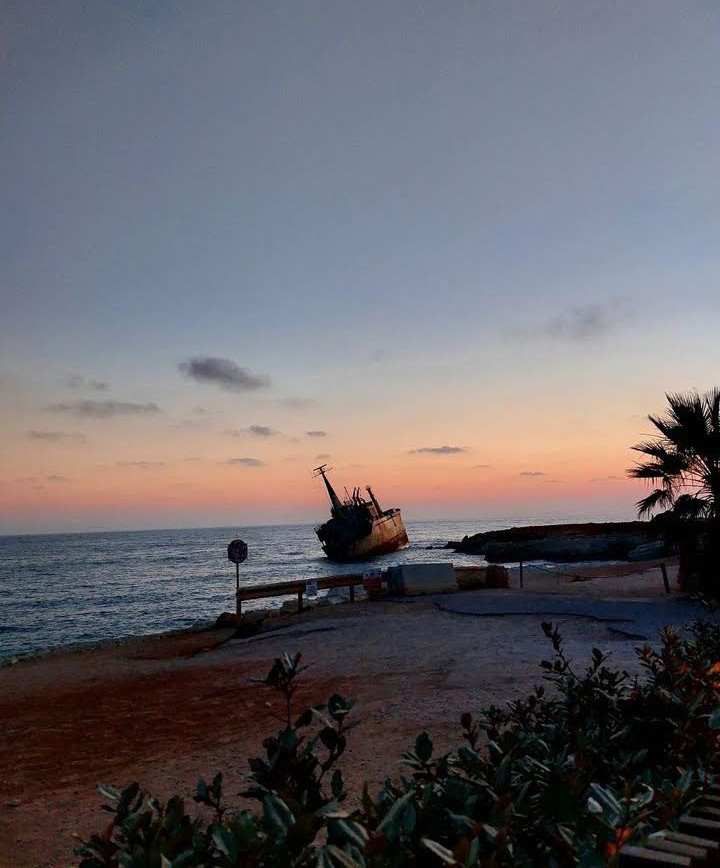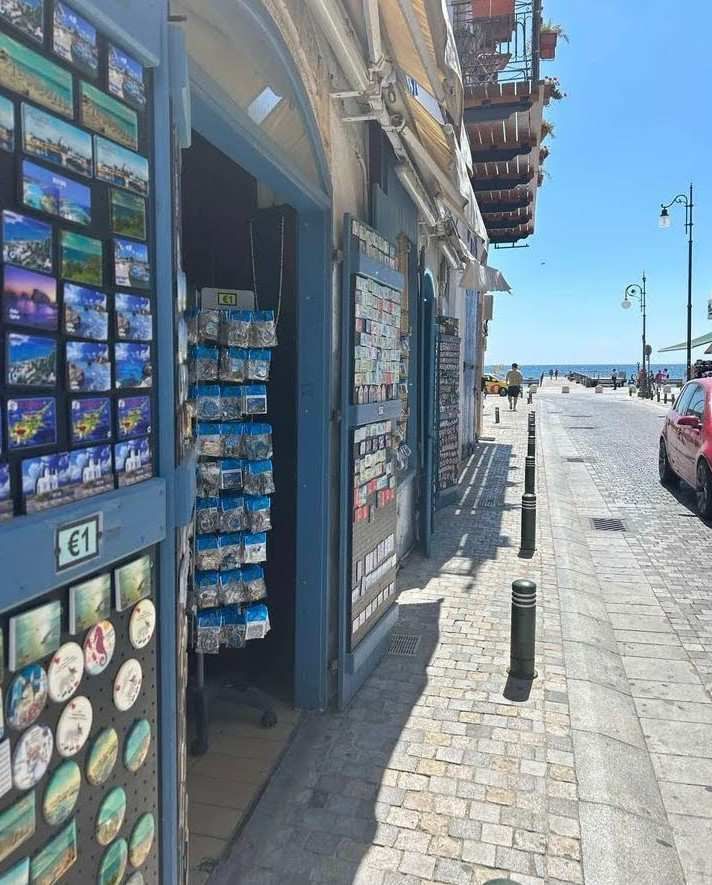
Nell’isola di Cipro, storica autostrada del Mediterraneo orientale, situata sulla costa della Siria e della Turchia, vivono in un’area di 9.345 km2 circa 1,5 milioni di persone di due gruppi etnici, greco e turco. La capitale Nicosia ospita circa 250.000 persone. La storia del processo di adesione all’UE è contraddittoria
The island of Cyprus, a historic highway in the eastern Mediterranean located on the coast of Syria and Turkey, is home to about 1.5 million people of two ethnic groups, Greek and Turkish, living in an area of 9,345 square kilometers. The capital Nicosia is home to about 250,000 people. The history of the EU accession process is contradictory

La sua capitale è attraversata da una linea di demarcazione, segnata da decenni da un alto muro, che sulle mappe militari ha il colore “verde” dell'ufficiale britannico che lo disegnò. Circa un migliaio di caschi blu dell'ONU sono incaricati di monitorarlo dal 1974. A sud della linea, infatti, si trova la Repubblica di Cipro, con molti greco-ciprioti, Kypriaki Dimokratia, membro dell'UE dal 2004, conta 5.990 km2 . circa 1.000 abitanti. 1.125.000 abitanti. A nord della linea si trova la Repubblica turca di Cipro del Nord, che ha una maggioranza di turco-ciprioti e una superficie di 3.355 km2 nella sua zona strategica.
Its capital is crossed by a demarcation line, marked for decades by a high wall, which on military maps has the color "green" of the British officer who drew it. About a thousand UN blue helmets have been in charge of monitoring it since 1974. South of the line, in fact, is the Republic of Cyprus, with many Greek Cypriots, Kypriaki Dimokratia, a member of the EU since 2004, has 5,990 km2 . about 1,000 inhabitants. 1,125,000 inhabitants. North of the line is the Turkish Republic of Northern Cyprus, which has a majority of Turkish Cypriots and an area of 3,355 km2 in its strategic area.

Con una popolazione di 400.000 abitanti, la Turchia è ora riconosciuta in tutto il mondo. La divisione dell'isola, che dura dal 1974, è un recente risultato politico della ricca storia di Cipro. Isola vissuta nel Neolitico, ricca di rame, dove nella mitologia greca nacque la dea Venere, divenne tolemaica dopo la divisione dell'impero di Alessandro Magno e di Roma per sei secoli. Prima di allora era miceneo, assiro, egiziano e persiano. Senza dimenticare le rovine uniche di Salamina che distano 10 km. A nord di Famagosta, rappresentano l'arrivo dei Troiani sull'isola dopo la presa di Troia secoli prima della conquista romana. Fonte: Università del Texas, collezione di mappe della Biblioteca Perry Castaneda - per gentile concessione delle Nazioni Unite. della Biblioteca del Texas, Università del Texas ad Austin
Successivamente bizantini e arabi si contesero l'isola per tre secoli, tra il VII e il X secolo.
With a population of 400,000, Turkey is now recognized worldwide. The division of the island, which has lasted since 1974, is a recent political result of Cyprus' rich history. An island lived in the Neolithic period, rich in copper, where in Greek mythology the goddess Venus was born, it became Ptolemaic after the division of the empire of Alexander the Great and Rome for six centuries. Before that it was Mycenaean, Assyrian, Egyptian and Persian. Not forgetting the unique ruins of Salamis that are 10 km away. North of Famagusta, they represent the arrival of the Trojans on the island after the taking of Troy centuries before the Roman conquest. Source: University of Texas, Perry Castaneda Library map collection - courtesy of United Nations. of the Library of Texas, University of Texas at Austin
Later Byzantines and Arabs contested the island for three centuries, between the 7th and 10th centuries.

Dopo il I secolo, in seguito alle Crociate in Terra Santa, l'isola fu menzionata per la prima volta da Richard de Leon del XII secolo (che copiò i simboli della Repubblica di Genova per la sua creazione del Regno d'Inghilterra). ) ai Templari e poi ai Lusigna di Francia finché tre anni prima della conquista americana, nel 1489, fu conquistata dai Veneziani. Ma meno di cento anni dopo, nel 1571, contemporaneamente alla conquista della Libia, gli Ottomani completarono la conquista dell'isola da Famagosta. Il dominio ottomano di Cipro (gli Osmanli della tribù Oăhuz che provenivano dall'Asia centrale e conquistarono l'Anatolia alla fine del XV secolo) durò fino al 1878.
After the 1st century, following the Crusades to the Holy Land, the island was first mentioned by 12th-century Richard de Leon (who copied the symbols of the Republic of Genoa for his creation of the Kingdom of England.) ) to the Templars and then to the Lusignans of France until three years before the American conquest, in 1489, it was conquered by the Venetians. But less than a hundred years later, in 1571, at the same time as the conquest of Libya, the Ottomans completed the conquest of the island from Famagusta. Ottoman rule of Cyprus (the Osmanli of the Oăhuz tribe who came from Central Asia and conquered Anatolia in the late 15th century) lasted until 1878.

Il lungo periodo (307 anni) del dominio ottomano porterà al consolidamento delle etnie dei turchi che si aggiungeranno agli elementi preesistenti, prevalentemente ellenici. È stato segnalato il primo conflitto tra turco-ciprioti e greci tra il 1572 e il 1668. Nel XIX secolo, l'esaurimento dell'Impero Ottomano spinse la "Porta Alta" a cedere l'isola alla Gran Bretagna, cercando di costruire un'altra base per la sua talassocrazia nel Mediterraneo orientale, in cambio di protezione contro le tendenze espansionistiche della Russia zarista. . . . Per gli inglesi l'isola divenne una preziosa "chiave per l'Asia orientale". Tuttavia, la prevista vittoria della Gran Bretagna non fermò i combattimenti al loro interno.
The long period (307 years) of Ottoman rule will lead to the consolidation of the ethnic groups of Turks that will be added to the pre-existing, predominantly Hellenic elements. The first conflict between Turkish Cypriots and Greeks between 1572 and 1668 has been reported. In the 19th century, the exhaustion of the Ottoman Empire prompted the "High Gate" to cede the island to Britain, seeking to build another base for its thalassocracy in the eastern Mediterranean in exchange for protection against the expansionist tendencies of Czarist Russia. . . . For the British, the island became a valuable "key to East Asia." However, Britain's expected victory did not stop the fighting within them.

Per garantire il controllo dell'isola, che non accetta la forma di autogoverno, la Corona britannica ha continuato a seguire la legge di “separazione e dominio” tra i due paesi. Questa politica peggiorerà dopo la seconda guerra mondiale, quando iniziò il processo di distruzione e si fece più forte il desiderio di indipendenza dell'isola.
To ensure control of the island, which does not accept the form of self-government, the British Crown continued to follow the law of "separation and domination" between the two countries. This policy would worsen after World War II, when the process of destruction began and the island's desire for independence grew stronger.

Allo scoppio della prima guerra mondiale, Londra si impossessa dell'isola (5 novembre 1914) e, dopo averla ceduta l'anno successivo alla Grecia per incoraggiare ad allearsi con l'Intesa – ottenendo però il rifiuto di evocare sentimenti di tradimento. tra i turchi - organizzare la sua politica cipriota. A partire dagli articoli 115-117 del primo Trattato di Sèvres, e, in seguito alla rivoluzione kemalista nella guerra greco-turca del 1919-1922, con l’articolo 20 del Trattato di Losanna, firmato il 24, 1923, la Turchia ha riconosciuto il suo impegno e ha lasciato va. tutti i diritti di Cipro. Il 10 marzo 1925 Cipro divenne ufficialmente una provincia della Corona, nonostante l'opposizione di molti turco-ciprioti che iniziarono a lasciare l'isola. Il passaggio dalla sovranità turca a quella britannica non ha avuto alcuna conseguenza, soprattutto per la società turca i cui abitanti provenivano dalla più e più piccola minoranza, senza una propria organizzazione.
At the outbreak of the First World War, London took possession of the island (Nov. 5, 1914) and, after ceding it the following year to Greece to encourage it to ally with the Entente--gaining, however, the refusal to evoke feelings of treason. among the Turks--organized its Cypriot policy. Beginning with Articles 115-117 of the first Treaty of Sèvres, and, following the Kemalist revolution in the Greco-Turkish War of 1919-1922, with Article 20 of the Treaty of Lausanne, signed on 24, 1923, Turkey acknowledged its commitment and let va. all rights to Cyprus. On March 10, 1925 Cyprus officially became a province of the Crown, despite the opposition of many Turkish Cypriots who began to leave the island. The transition from Turkish to British sovereignty was of no consequence, especially for Turkish society whose inhabitants came from the largest and smallest minority, with no organization of their own.

Ma la comunità turca rappresenta un bene prezioso per le autorità britanniche che, a partire dal 1929, cominciarono ad attaccare l'irredentismo greco-cipriota. Così Londra si unì uno dopo l'altro ai turco-ciprioti con l'obiettivo di riequilibrare il benessere della comunità greca, cioè della maggioranza degli abitanti dell'isola, come hanno dimostrato gli eventi del 1931. All'epoca del tentativo di ribellione di Enosis (cioè dell'unità dell'isola con la patria greca, Enosis) a Nicosia - in seguito allo scioglimento da parte del governo britannico del consiglio legislativo composto da greco e turco-ciprioti, direttamente in carica - un portavoce di il governo turco. Il popolo del paese giurò fedeltà alla corona britannica. Iniziò così il processo di indipendenza politica sostenuto dai turco-ciprioti. Dopo la seconda guerra mondiale, il 27 febbraio 1947
But the Turkish community represented a valuable asset to the British authorities who, starting in 1929, began to attack Greek Cypriot irredentism. Thus London joined one after another with the Turkish Cypriots with the aim of rebalancing the welfare of the Greek community, that is, the majority of the island's inhabitants, as the events of 1931 showed. At the time of the attempted rebellion of Enosis (i.e., the unity of the island with the Greek homeland, Enosis) in Nicosia - following the dissolution by the British government of the legislative council composed of Greek and Turkish Cypriots, directly in office - a spokesman for the Turkish government. The people of the country swore allegiance to the British crown. Thus began the process of political independence supported by the Turkish Cypriots. After World War II, on February 27, 1947.

, il Parlamento di Atene approvò una risoluzione che chiedeva l'unione di Cipro con la Grecia. Forte di questa posizione, infatti, dell'impatto dell'espulsione britannica dalla Palestina (novembre 1947-maggio 1948), negli ultimi mesi del 1949, l'allora vescovo di Kitio, Michael Mousikos, nominò un po' dopo l'arcivescovo ed etnarca nel nome di Makarios. III, iniziò ad assumere il ruolo di leader politico e organizzò elezioni tra i greco-ciprioti nel gennaio successivo, il 96% di loro (215.108 persone) dichiarò di sostenere Enosis, temendo che la minoranza turco-musulmana si trovasse di fronte alle aspettative del governo greco. . governo. Di fronte alle richieste dei greco-ciprioti per l’attuazione di Enosis, inglesi e turco-ciprioti si sono trovati uniti nell’obiettivo di impedire in qualsiasi modo l’unione con la Grecia, preferendo mantenere uno stato attuale o, in mancanza, un confine. divisione.
, the Athens Parliament passed a resolution calling for the union of Cyprus with Greece. On the strength of this position, in fact, of the impact of the British expulsion from Palestine (November 1947-May 1948), in the last months of 1949, the then Bishop of Kitio, Michael Mousikos, appointed a little later archbishop and ethnarch in the name of Makarios. III, began to assume the role of political leader and organized elections among Greek Cypriots the following January, 96 percent of them (215,108 people) declared their support for Enosis, fearing that the Turkish-Muslim minority would be faced with the expectations of the Greek . government. Faced with Greek Cypriot demands for the implementation of Enosis, British and Turkish Cypriots were united in their goal to prevent union with Greece in any way, preferring to maintain a current state or, failing that, a border. division.

. Pertanto, gli sforzi di Makarios hanno cercato di porre fine alla situazione sull'isola, sia a causa dei rapporti tra la Gran Bretagna e i turco-ciprioti, ma anche a causa della situazione internazionale emergente. Con la dottrina del contenimento dell'URSS (12 marzo 1947), rivelata dalla dottrina di George Kennan, e il "Piano Marshall" (5 giugno 1947), gli Stati Uniti gettarono le basi del diritto in Europa. con l’operazione antisovietica, il blocco occidentale, che prese poi forma nel Patto Atlantico, firmato il 4 aprile 1949.
. Therefore, Makarios' efforts sought to end the situation on the island, both because of the relations between Britain and the Turkish Cypriots, but also because of the emerging international situation. With the doctrine of containment of the USSR (March 12, 1947), revealed by George Kennan's doctrine, and the "Marshall Plan" (June 5, 1947), the United States laid the foundations of law in Europe. with the anti-Soviet operation, the Western bloc, which later took shape in the Atlantic Pact, signed on April 4, 1949.

La regione dell’Egeo è quella più direttamente coinvolta, con la Grecia da un lato impantanata in una devastante guerra civile tra conservatori e forze comuniste, e dall’altro la Turchia che deve far fronte all’espansione russa nel sud-ovest. l'altro esprimeva la sua debolezza interiore. Inoltre, nell'agosto 1950, la Turchia chiese di aderire al Patto Atlantico e tra il settembre 1951 e il febbraio 1952 poté aderire alla NATO, quasi contemporaneamente all'ingresso della Grecia (1951). vero e proprio tra i tre paesi. Rispetto a questo sistema geopolitico, lo scopo di Enosis è inaccettabile.
The Aegean region was the most directly involved, with Greece on the one hand mired in a devastating civil war between conservatives and communist forces, and Turkey on the other facing Russian expansion in the southwest. the other expressed its inner weakness. In addition, in August 1950, Turkey applied to join the Atlantic Pact, and between September 1951 and February 1952 it was able to join NATO, almost simultaneously with the entry of Greece (1951). real between the three countries. Compared to this geopolitical system, the purpose of Enosis is unacceptable.

Che si tratti del Regno Unito (coinvolto nella Guerra Fredda contro l’URSS), o della Grecia (entrata nell’orbita occidentale dalla guerra civile), o della Turchia (filo-occidentale e ora attenta ai bisogni dei suoi pari). Ovest"). L'importanza dell'isola per Londra non diminuì, anzi, la divisione dell'Europa in sfere di influenza e avversari accrebbe il valore strategico di Cipro: da anello di protezione imperiale a pietra angolare del crollo del sole d'Oriente. Mediterraneo e Medio Oriente. A questa situazione si scontrarono ripetuti sforzi di opposizione da parte dell'arcivescovo Makarios:
Whether it is the United Kingdom (involved in the Cold War against the USSR), or Greece (brought into the Western orbit by the civil war), or Turkey (pro-Western and now attentive to the needs of its peers). West."). The island's importance to London did not diminish; indeed, the division of Europe into spheres of influence and adversaries increased Cyprus's strategic value: from imperial ring of protection to cornerstone of the collapse of the Eastern Sun. Mediterranean and Middle East. This was met with repeated opposition efforts by Archbishop Makarios:

la richiesta dell'arcivescovo al governo greco nel 1951 affinché l'Assemblea generale indagasse sugli avvenimenti di Cipro non venne soddisfatta. Nazioni Unite, la richiesta di Makarios fu immediatamente comunicata all'ONU nell'agosto 1953. La Gran Bretagna concesse l'indipendenza all'isola solo nel 1959, dopo la conferenza della Lancaster House del 17-19 febbraio che riunì rappresentanti britannici, greci e turchi. I tre Stati firmatari potrebbero intervenire militarmente sull’isola se si ritenesse che la nuova Costituzione cipriota adottata nel 1960 fosse in pericolo, conformemente alle disposizioni dei due trattati di alleanza e di garanzia, mentre il Regno Unito conservasse la piena sovranità dei due Paesi. basi ad Akrotiri e Dhekelia come Area di Sovranità (SBA). Inoltre, l'ubicazione dell'aziendaarchbishop's request to the Greek government in 1951 for the General Assembly to investigate the events in Cyprus was not fulfilled. United Nations, Makarios' request was immediately communicated to the UN in August 1953. Britain did not grant independence to the island until 1959, after the February 17-19 Lancaster House conference that brought together British, Greek and Turkish representatives. The three signatory states could intervene militarily on the island if it was deemed that the new Cypriot Constitution adopted in 1960 was in jeopardy, in accordance with the provisions of the two treaties of alliance and guarantee, while the UK retained the full sovereignty of the two countries. bases at Akrotiri and Dhekelia as a Sovereignty Area (SBA). In addition, the location of the
Congratulations, your post has been upvoted by @dsc-r2cornell, which is the curating account for @R2cornell's Discord Community.
Enhorabuena, su "post" ha sido "up-voted" por @dsc-r2cornell, que es la "cuenta curating" de la Comunidad de la Discordia de @R2cornell.